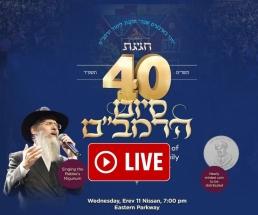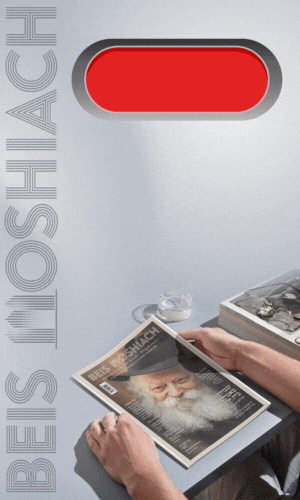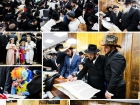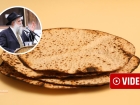Israel #1 “Scoopist” Collects Scoops from the Rebbe
Israeli Journalist Shlomo Nakdimon was for decades considered the #1 “scoopist” in the ranks of the Isreali press. In an interview we recently conducted with him, Nakdimon told us about his three meetings with the Rebbe Melech HaMoshiach, the first one of which lasted for over an hour-and-a-half • By Beis Moshiach Magazine • Full Article
Mendy Dickstein, Beis Moshiach
These were the days of anxiety just before the Six Day War. Reserve soldiers in the Israel Defense Forces were called up right down to the last man. Arab armies were applying pressure at the borders of Eretz Yisrael from every possible direction. The voices emanating from Cairo and Damascus warned of the destruction of the Jewish People. Vast parcels of land were prepared for use as temporary cemeteries. It seemed that the overall situation was about to slip out of control.
At the height of these dark days, an urgent meeting was called by the secretariat of Mapai, the ruling party in the coalition government headed by Prime Minister Levi Eshkol. The main topic for discussion would be the significant political and public pressure to appoint a new defense minister: former IDF chief of staff Moshe Dayan, then a rank-and-file Knesset Member with the Rafi Party, which had broken away from Mapai. The move would be perceived as an attempt to wrest the defense portfolio from Mr. Eshkol, who then served both as prime minister and defense minister.
During the debate, Mapai secretary general, Mrs. Golda Meir, complained that everything stated at meetings of the secretariat, the party’s main institution, was leaked to the press. Thus, quotes were made directly from the secret protocol of this meeting: “Last night, before we concluded the meeting [the previous one when they discussed this same issue], everything was already in the hands of the journalist Nakdimon. No angel from Heaven told these things to Nakdimon, rather a person who sat in the secretariat meeting.” The person complaining expressed hope that this will not be repeated, as “the things the prime minister is speaking about are subject to censorship.”
The things about which she was referring were behind-the-scenes secret contacts with the United States. However, her hopes were dashed and by that very night, details of the fateful discussion, including the above quote, were already in the hands of the journalist, Shlomo Nakdimon, our interviewee for this article.
It seems that the rebuking comments of the powerful party leader towards her party colleagues illustrated the scope and ability of Nakdimon’s journalistic activities. By virtue of his role as a reporter and commentator on politics and government, he didn’t deal just with covering current events, rather he investigated political affairs, including matters of a highly confidential nature. Nothing stopped him from accessing such material before anyone else. Testimony to this effect comes in the form of a note written to Nakdimon by then-defense minister Moshe Dayan during the height of the internal government crises following the Yom Kippur War. “Nakdimon, you know everything – what’s happening in the National Religious Party? Why have they discouraged [then prime minister] Golda from going to the president at ten o’clock this evening?”
***
Nakdimon’s journalistic career began in 5717 (1957) with the right-wing “Herut” party newspaper, and from 5726 (1966), with the “Yediot Acharanot” daily, where he was considered the country’s #1 scoop artist. Golda Meir was right when she complained sadly that even before critical high-level government, political, or national union meetings had finished, all the information was already in the hands of Shlomo Nakdimon (“Nakdi”, as his friends call him), information which in most cases became his newspaper’s headlines.
ORIGINS
Shlomo Nakdimon was born Shlomo Kaminker in Haifa in 5696 (1936) to a chareidi family with Zionist leanings. When he was an infant, the family moved to Tel Aviv, living in the southern part of the city for many years. His father, Yitzchok Asher Kaminker, was a pioneer who performed all forms of difficult tasks – agricultural, construction, and in polishing diamonds. At the same time, he was counted among the founders of the ultra-Orthodox Poalei Agudat Yisrael Party, registered as its first member, and there’s even a street in Petach Tikva named after him. On occasion, he also published articles in the newspapers and periodicals of the time.
Shlomo was a very curious boy, and he preferred the newspapers his father brought home over his school textbooks. Sometimes, he would even send an article to the General Zionist Party journal – “HaBoker.” His early work went to the paper’s literature supplement. Its editor, Baruch Karu, invited him to appear before the editorial board and was surprised to see a slim young man who has just completed his compulsory military service. He told Shlomo that while his piece was not suitable for the literature supplement, he would make certain to publicize it in the paper’s op-ed section. The subject – the Kastner Affair.
Before his army induction, Shlomo worked in an attorney’s office, because he was planning to study law. In 5716 (1956), he was released from the IDF and started looking for work. The major newspapers were out of bounds for young people. In the meantime, he served as a reporter with the “Tenufa” youth newspaper, and he even covered law and justice stories for the “Rimon” illustrated magazine. He eventually chose to work for the “Herut” Movement daily, and its editor, Aizik Remba. Here Shlomo Kaminker flourished, alongside a group of several young and aspiring journalists, eventually adopting the pen name he uses today as his surname.
Remba placed him in charge of covering political stories and also gave him a weekly column on the performing arts. In Shvat 5721 (January 1961), he crawled into the ventilation system at the “Ohel” Theatre, and was a witness to the process of removing Pinchas Lavon from his role as secretary general of the Histadrut labor union during a closed-door meeting of the Mapai Central Committee. The background was the famous political scandal that got the name “Esek Bish” — the unfortunate affair” (something equivalent to the Watergate Scandal in the USA) that happened during 5714-5715 (1954-55), when Lavon served as defense minister and dragged the Mapai leadership into internal warfare. Even though his presence remained undisclosed, Nakdimon was caught by Prime Minister David Ben-Gurion’s security agents, was placed in prison over trumped up charges, and was later released on bail.
Nakdimon’s arrest aroused considerable commotion among the Israeli media. The “Herut” daily had a big scoop, and at “Yediot Acharanot”, staff coordinator Dov Yudkovsky called a meeting of his reporters and demanded: “I want all of you to be Nakdimon!” Nakdimon was put on trial, charged with the peculiar charge of “entering a theatre without a ticket to annoy its patrons.” The judge ruled, “Mr. Nakdimon need not respond to the charges…”
With the closing of the “Herut” newspaper, Nakdimon was offered a position with “Yediot Acharanot”, and within a short period of time, he became one of the paper’s star reporters, bringing in numerous scoops. A common sight at the paper’s information desk was a large envelope waiting for him containing the protocols of some confidential meeting. His revealing articles on the stormy political climate during the waiting period prior to the Six Day War served as a basis for his first book, “Towards The Zero Hour.”
Other books followed, foremost among them: “Altalena”, about the Irgun military cargo ship blown up by IDF cannon fire on the shores of Tel Aviv in 5708; “First Strike”, documenting the story of the attack on the Iraqi nuclear reactor in 5741; “Low Probability”, dealing with the subject of the Yom Kippur War; “Fallen Hope”, on the Mossad activities on behalf of the Kurds in northern Iraq and others.
Over the years, Nakdimon investigated several secret affairs in the history of the Jewish homeland. He even revealed the truth behind certain matters previously considered unsolvable, e.g., the assassination of the “foreign minister of the ultra-Orthodox sector”, Dr. Yaakov Yisrael de Haan in 5684. He also wrote (together with Aviezer Golan) a biography of Menachem Begin, with whom he had strong connections for many years.
Over the years, he was even privileged to receive numerous awards for his outstanding work in journalism.
It would seem that the things that “Yediot Acharanot” editor Dov Yudkovsky said about Nakdimon accurately summarized his way of life. “After working for many years with Shlomo Nakdimon, I can attest to the fact that he is graced with all the proper characteristics of a top-notch journalist – intelligence, curiosity, diligence, wide-ranging vision, vast knowledge, skills as a writer, credibility, and decency. These characteristics, combined with his untiring vitality, connected nicely together with his journalistic activities, which became a way of life.”
“THE REBBE’S IMAGE CONSTANTLY HOVERED OVER THE POLITICAL SYSTEM IN ISRAEL”
At the height of such a busy network of activities, Nakdimon derived unusual pleasure and satisfaction from the three visits he made to see the Rebbe, MH”M. During the first visit (5722/1962), he interviewed the Rebbe, at the second (5737/1977), he covered the visit of Prime Minister Menachem Begin, and during the third (5750/1990), he was privileged to participate in a public farbrengen with the Rebbe and later met with him at the dollars distribution.
“The Rebbe’s image was constantly hovering over the political system in Eretz Yisrael. No, he was not a political figure, however, his presence was definitely there,” said Shlomo Nakdimon. “Questions of religion and state were constantly a subject of discussion, causing deep political tension. Chabad ‘lobbyists’ filled the halls of government, located ways to contact the offices of the premier and his Cabinet ministers, were regularly present in the Knesset building and its hallways, lying in wait for those designing public policy, and leaving no stone unturned. Another area for action among the Chabad activists was and is in the IDF, primarily on Jewish holidays.
“While a fair number of people wearing both black and knitted kippot have been elected to the Knesset, the number of Chabad activists has been far greater. These people are always full of enthusiasm, always saying, ‘The Rebbe said.’ The rest is interpretation. No obstacle will stand in their way.
“The Rebbe sent shluchim all over the globe,” Nakdimon said, “and I understood that there is one source for this widespread activity, and it’s in Brooklyn – at 770 Eastern Parkway. Everything’s there: the Rebbe’s place of residence, his Beis Medrash, his office – during the day as well as at night. I asked to come to the Rebbe, to see him face to face, and also to ask him why he doesn’t transfer 770 to Eretz Yisrael, to Yerushalayim, to Kfar Chabad, to wherever he wants in the Promised Land.”
One Tuesday night in late Adar Rishon 5722 (1962), Nakdimon arrived at his destination and was welcomed by the Rebbe’s legendary head secretary, Rabbi Chodakov.
“He described to me the Rebbe’s daily schedule. He accepts visitors three times a week – Sundays, Tuesdays, and Thursdays – starting from eight in the evening. His door was usually open to them until one o’clock in the morning, although this time limitation didn’t stand up to the test of reality. These meetings sometimes finished at daybreak. On their own, the activities in the Rebbe’s court constitute a subject worth writing about.
“That Tuesday night,” Nakdimon described, “the Rebbe’s ‘court’ was filled with many hundreds of Chassidim. I had conversations with several Chassidim to listen to their requests. The questions and appeals were on almost every aspect of life. It became clear to me that the Rebbe wasn’t always conclusive in his reply. For example, on medical matters, he quite often advised that the person undergo additional tests. On halachic subjects, he would send people to rabbanim who deal with the issue at hand. Businessmen told how their businesses succeeded in the Rebbe’s merit.”
At eleven p.m., the bell rang in Rabbi Chaodakov’s room. A blue light flashed. Nakdimon’s host told him to get ready to enter the Rebbe’s room. A couple together with a young man left the room, and he walked in. He described the experience in an article he later publicized:
“The Rebbe sat near his long table. On his head was a black Chabad-style hat, his black beard appeared well kept, neat. As I observed him from across the room, something happened to me during those moments that I can’t explain. I was speechless. I remained standing as I gazed at the Rebbe, totally enraptured. With a smile on his face, he asked me in Yiddish, ‘Why are you standing there? Please come closer.’ I walked towards him. We shook hands, and I sat on a chair designated for guests.”
Nakdimon kept looking at his host, the Rebbe. “For me, a young journalist, this was a unique experience. I was raised in an ultra-Orthodox home, albeit not Chassidic, but also not of misnagdim.
My two grandfathers, one a shochet and kashrus mashgiach, the other a businessman, both stringently observed Torah and mitzvos to the letter, and had great admiration for rabbanim and Rebbes, although they didn’t regularly knock on their doors.”
As he described it, Nakdimon became aware of the Rebbe’s stature through his professional writings as a journalist. The problem on the question of “Who is a Jew?” was a front-burner issue desperately in need of a legislative remedy, and the Rebbe’s shluchim were heavily involved. As he delved more into the matter, he found that the Rebbe was a leader who radiated tremendous dynamism, a most charismatic personality who enthralled thousands of Chassidim while serving as a lighthouse for key individuals throughout Eretz Yisrael and the world at-large. These people knew the depth of his wisdom and the extent of his influence.
As the conversation continued, Nakdimon noticed that the Rebbe refrained from using the term “The State of Israel,” using instead expressions such as territory, organization, location, gathering, etc. When Nakdimon expressed his wonder over this, the Rebbe responded that his manner of answering relates to every Jewish community in the world. His words focused on the historical annals of the Jewish People, its political, social, and physical turmoil, and its joint and unifying struggles. In the Rebbe’s estimation, the unity of the Jewish People is in the fulfillment of practical mitzvos, i.e., observing Shabbos, putting on tefillin, keeping kosher, etc. Those who didn’t keep these three mitzvos eventually died out. Some assimilated among the other nations of the world where they lived, and there were those who regretted their actions and returned to mitzva observance.
In any event, how did the Rebbe relate to the modern Jewish state?
The Rebbe replied that the Jews first entered Eretz Yisrael during the time Yehoshua bin Nun. Since then, the place has been sanctified as Eretz Yisrael and Yerushalayim. However, anything that weakens the actual fulfillment of mitzvos weakens the existence of the Jewish People, and in so doing, the power of its physical presence.
“You will find many people,” I replied, “who will absolutely reject the Rebbe’s position.” The Rebbe responded to this with a decisive reply, and this was the first time that he mentioned the state of Israel by name. “If we would always give consideration to the majority opinion, and everything would be put to a vote, there would never be a Jewish state in Eretz Yisrael, because the majority was against it. If they would ask if they should fight the British, the majority would say no. This is the position in a war against four hundred million Arabs; the majority would claim that we would lose. In other words, the whole reality in Eretz Yisrael stands in opposition to the majority and in opposition to common sense. They did what they did out of faith. Many felt this even if it was in their subconscious. People should try to fulfill mitzvos, and experience has proven that it goes quite well. This task falls upon the ministry of education.”
“And what if the ministry is headed by a Jew who does not observe mitzvos?” Nakdimon asked, and the Rebbe replied: “Was he, the minister of education, born with the ministry of education?”…
The Rebbe’s suggestion was to locate five historians devoid of any preconceived notions, experts in Jewish history, and have them assess his suggestion. It was clear to the Rebbe that they would draw the conclusion that mitzva observance is the way to go.
Addressing how viable this can be for a full-fledged Jewish state,the Rebbe suggested bringing an example from the days of the First Beis HaMikdash: “There was a government then, there was an army, there was a navy, and they conducted commerce with Tzur, Tzidon, and the surrounding kingdoms, when foremost among the desires of the people stood the spiritual center – the Beis HaMikdash.”
Shlomo Nakdimon now felt that this was the appropriate moment to ask his question: Why doesn’t the Rebbe himself in all his glory emigrate to Eretz Yisrael and wage the war for Torah and mitzvos from there? He asked and the Rebbe replied: “There are few important matters which are preventing me from leaving my present location. Traveling to Eretz Yisrael shouldn’t be just for pleasure, but to achieve something. When the reasons that are obligating me to stay in the United States no longer apply, what I can accomplish there can be considered.”
Nakdimon recalls a practical story on this matter regarding his friend, Rabbi Shlomo Goren, former IDF chief rabbi, who posed a similar question to the Rebbe during one of his visits to 770. Rabbi Goren asked it four times and received four answers on four different occasions, each one different from the other.
It stands to reason that someone else might perceive the Rebbe’s answers as an effort to be evasive. However, Rabbi Goren believed the Rebbe, relating to him as a giant in all matters of Jewish thought, his leadership skills, and his drive for more activities. He even wrote this in an article in the “Haaretz” daily.
YES, THEY CAN REACH THE MOON
Mr. Shlomo Nakdimon continues to bring personal memories, together with his accompanying commentary, from his first visit to the Rebbe:
“In contrast to his contemporaries among the courts of other Chassidic masters, the Rebbe was greatly esteemed for his vast academic intelligence and his measured approach, even in his external knowledge. He is a prominent man of science, a graduate of Sorbonne University in Paris, receiving a degree in electrical engineering.
“I asked him: ‘What is the Rebbe’s opinion on Glenn’s achievement?’ [a reference to Col. John Glenn, the NASA astronaut who on 16 Adar Rishon 5722 (1962) became the first American to orbit Earth].”
The Rebbe: This is a technical matter.
I asked: And the moon, the small luminary, can they reach it?
The Rebbe: They can reach the moon.
S.N.: And what will they find when they reach it?
The Rebbe (smiling): We’ll see what they find there when we reach it. If I’ll say what they will find there, they won’t want to reach the moon…
S.N.: And how does the Torah look upon these human efforts?
The Rebbe: From a professional standpoint, the scientific discoveries in the field of the atom, atomic particles, and the relevant existing laws pertain more to Jewish philosophy than to the conquest of space. The conquest of space is another step toward scientific and technical progress.
While the discoveries in atomic theory shake the foundation of science that have prevailed until now — they then said that science is stable, whereas the Torah is merely faith — now we see that all foundations of science thus far, all scientific assumptions in physics and technique, have no existing basis in truth. This became known specifically with the discoveries in atomic theory. Thus, all questions from science on religion fall by the wayside, since all scientific theories have to be reappraised from A to Z.
The Rebbe’s prediction: We will see that every additional practical achievement in the study of atomic particles further undermines existing scientific accomplishments, requiring a serious reassessment of previously held concepts.
S.N.: And the Torah doesn’t prevent or forbid the exploration of space?
The Rebbe: The Torah has no objection to continued exploration.
***
“From the atom and space, I made a small detour back to Eretz HaKodesh, and we began a discussion on the religious parties,” Nakdimon recalled. “I asked the Rebbe for his opinion on them. I presented him with claims by religious people rejecting the existence of these parties, while mentioning the actions taken by religious Knesset representatives.”
The Rebbe: In the current situation, there is no other alternative. Every matter requires protection via representation in the Knesset, thus there is a need for membership in political parties. I am not taking a position towards the religious parties because I am not in Eretz Yisrael. However, according to the prevailing situation, there must be representatives in the Knesset whose main concern is defending matters of religion.
While the conversation continued to develop, they soon began to touch upon subjects that were discussed on the condition that they not be publicized.
The interview was over. Nakdimon sat with the Rebbe for another few minutes, and then he asked to know what he, as a journalist, could do for Chabad. The two continued their discussion, and among other things, the Rebbe expressed interest in journalists from Eretz Yisrael staying in the United States.
***
NAKDIMON REPORTS ON THE PRIME MINISTER’S VISIT TO THE REBBE
Nakdimon’s second meeting with the Rebbe took place about fifteen years later, in the summer of 5737 (1977), when Prime Minister Menachem Begin received the Rebbe’s blessing on the eve of his visit to Washington to meet with President Jimmy Carter. These discussions were meant to initiate a diplomatic effort towards peace with Egypt.
“It was ten o’clock in the evening. Thousands gathered in the square in front of 770, the Rebbe’s official headquarters,” Nakdimon described the meeting at the time for ‘Yediot Acharanot.’ “A police vehicle led the caravan, followed by cars of the American and Israeli security services, and a black Cadillac with U.S. and Israeli flags waving – bearing the prime minister of Israel. Security men carrying drawn pistols leapt out of their vehicles while they were still moving.
“Begin got out of his car and was greeted by thunderous applause. He turned to the crowd and waved his hands towards them. From the other direction, the Rebbe came out of his room, walked towards his guest, shook his hand with a big smile, and introduced Rabbi Chadakov to him. Begin introduced his chief of staff, Yechiel Kadishai. At the entrance, the Rebbe motioned for Begin to go in first, but Begin bestowed the honor upon his host.”
Nakdimon then described the meeting in great detail. Among other things, he noted: “When Begin was asked by one of the journalists why he wanted to meet with the Rebbe, he replied: ‘He is one of the great leaders and elders of our generation. We don’t just know him in Israel, we listen to his voice and hear his advice. Before leaving for Washington, I felt the need to consult with him and receive his blessing.’
“At the end of the meeting between the two men, the Rebbe blessed Begin before the cameras with ‘complete success for the Jewish People, for Eretz Yisrael, and may he merit to hasten the Complete Redemption,’” said Nakdimon, as he concluded his recollection of that meeting.
THE REBBE TO THE REPORTER: IT’S A SIGN THAT YOU’RE BUSY…
Thirteen years later, on Erev Shabbos Chazon 5750 (1990), Nakdimon made his third visit to the Rebbe, accompanied by his young son Yaniv. His host was his friend, fellow Yediot journalist and editor of The Algemeiner Journal Gershon Jacobson.
Nakdimon davened the Shabbos tefillos in the Rebbe’s Beis Medrash, where many people participated, far beyond the shul’s capacity. “The anticipation always was for the event called a farbrengen, a gathering during which the Rebbe spoke about the weekly Torah portion.
“The Rebbe sat on the platform in the center of the Beis Medrash, and during [the farbrengen], he spoke four times and in between held up a cup of wine for ‘L’chaim’, as his eyes surveyed all those sitting in the Beis Medrash from one end to the other. It seemed that the Rebbe was catching with his glance the eyes of each of the Chassidim, giving them the feeling as if he was the only guest. Facing him, the Rebbe’s eyes met those of that guest as he held a cup in his hand. A thrilling meeting of the eyes. I followed the eyes of the participants, and I noticed that each of those present undoubtedly felt that way.
“The Rebbe’s talk continued for about forty-five minutes, and at its conclusion, R’ Leibel Groner invited me to the hallway leading from the Beis Medrash to the Rebbe’s room. ‘When the Rebbe passes by, you can exchange a few words with him,’ he promised me.
“And so, a short while later, the Rebbe came. After I introduced my son to him, the Rebbe turned to me with one word – ‘Ra’iticha’ [= I saw you]. I asked if he remembered my visits to him and the interview that I conducted with him in 5722. ‘Certainly,’ the Rebbe replied, and then with a playful smile, he continued, ‘however, you haven’t been here since then, and this is a sign that you are a busy man.’”
The following day, Sunday, the seventh of Menachem Av, Nakdimon and his son stood in line for dollars distribution.
“I presented the Rebbe with the English edition of my book documenting the Israel Air Force’s destruction of the nuclear reactor in Iraq. ‘Why in English?’ the Rebbe asked, and I replied that the Hebrew edition (“Tammuz in Flames”) had run out. The Rebbe examined the cover and asked if this was my most recent book, and when I answered in the affirmative, he replied, ‘It should be with great and glorious success.’
“As I thanked the Rebbe for his bracha, the Rebbe took another dollar from the pile, gave it to me and added, ‘This is for much success in your writing…’
“At this point, The Rebbe proceeded to speak about the name ‘Nakdimon.’ I told him about the circumstances behind the name change, and the Rebbe asked if I know the source of my name. As I began to tell what is known about the historic Nakdimon ben Gurion, the Rebbe asked me to let him tell the story as it appears in Torah sources.
“He said that it is stated in the Gemara that Nakdimon ben Gurion supplied water to the residents of Yerushalayim during a water shortage, and ‘there is no water except Torah.’ Thus, the Rebbe continued, you must make use of your writings to write words of Torah openly with your signature. ‘Then, you will find a new group of people that you can influence, and in the meantime [in other words, at this opportunity], they will be also influenced from the Torah.’
“I thanked the Rebbe for his words and our discussion continued. In response to my question whether he was satisfied with the existing government in Israel, the Rebbe asked with a smile if I wanted to use the conversation for politics as well.
“Why not?” I replied to the Rebbe in my role as a journalist-author who is also an historian. ‘The best politics is that these days should be converted into gladness and joy.’
“During this period, Shimon Peres had failed in his attempt to bring down the government of Yitzchak Shamir, and with the Rebbe’s encouragement, a narrow government was formed under Shamir’s leadership. The Rebbe explained to me that his positive attitude towards the Shamir government stems from Torah law, according to which pikuach nefesh overrides several matters. Therefore, ‘there is a need for a strong and narrow government, as a wide government is constantly busy talking and is unwilling to produce anything in full.’
“The message that the Rebbe wanted me to convey was that ‘the government must be strong like Shamir, because Shamir in Lashon Ha’kodesh is a worm that splits hard rock. Thus, Shamir should place this upon the stone hearts around him, i.e., those surrounding him who have opinions differing from him.’
“When the Rebbe asked me if I know Prime Minister Shamir personally, I replied in the affirmative. I was then asked to convey the following message to him: ‘Be like the Biblical Shamir that breaks through stone.’”
Here, the Rebbe and Nakdimon parted from one another, “when the Rebbe gave me his marvelous, reassuring, and heartfelt smile.”
Nakdimon quickly telephoned the prime minister’s office in Yerushalayim and gave over the exact wording of the Rebbe’s message. While the prime minister was not mitzva observant, he admired the Rebbe very much.
“This experience was my third and final meeting with the Rebbe,” Shlomo Nakdimon said in conclusion of his recollections of those special minutes and hours he spent in the Rebbe’s presence.
***
EPILOGUE
It would be interesting here to bring the testimony of Rabbi Efraim Wolf, director of the central Yeshivas Tomchei Tmimim in Eretz Yisrael, who wrote a letter to the Rebbe in Sivan 5732 (1972). “Mr. Shlomo Nakdimon reports that he spoke with Mr. Moses [publisher of the ‘Yediot Acharanot’ daily], and he was most impressed by his visit with the Rebbe shlita. In his words, the Rebbe said that he is interested in Nakdimon’s articles […] and this caused much pleasure to Mr. Nakdimon.”
*
The magazine can be obtained in stores around Crown Heights. To purchase a subscription, please go to: bmoshiach.org
152
Join ChabadInfo's News Roundup and alerts for the HOTTEST Chabad news and updates!










































